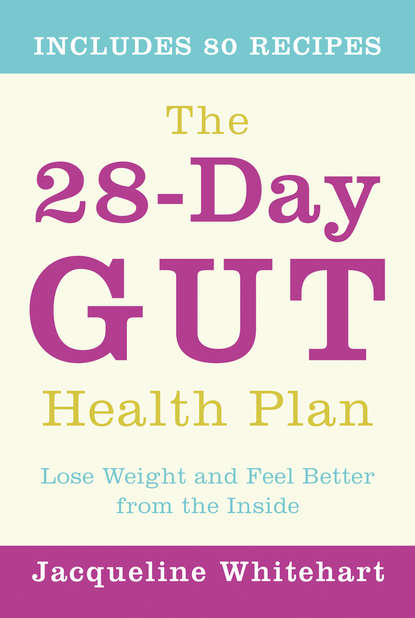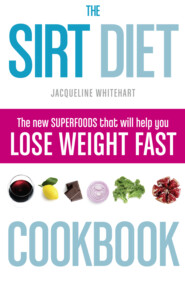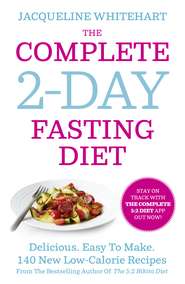По всем вопросам обращайтесь на: info@litportal.ru
(©) 2003-2024.
✖
The 28-Day Gut Health Plan: Lose weight and feel better from the inside
Автор
Год написания книги
2018
Настройки чтения
Размер шрифта
Высота строк
Поля
The most proven and the one now being prescribed by specialists for IBS and similar illnesses is a brand of probiotic called VSL3 (www.vsl3.co.uk (http://www.vsl3.co.uk)). This brand contains the most strains of good bacteria and has 450 billion bacteria per sachet. But it is expensive and needs to be kept refrigerated.
THE BLOATING PROBLEM
Probiotics plus more fibre can lead to extra bloating in the first week of the programme. When you start taking probiotics you could get more bloated not less. But if you care about improving your gut health, it’s a really important step. And in a strange way, it shows that the probiotics have started to do their job. They’ve started the battle and are breaking down foods that your body normally doesn’t digest, producing more gas. Give the probiotics a week during the Rest and Restore phase and you’ll see the bloating reduce. At the end of the week, your waist size and bloating will have reduced and be back to normal. You might even have lost weight and an inch or two round your tummy.
The more traumatized your gut the worse this will be. Give it a week. It will get better. And it means that a change for the better has begun. Don’t start the Introducing phases until it is resolved.
FIBRE VS INTOLERANCE
One of the key tenets of improving your gut health and soothing your bowel symptoms is keeping levels of both soluble and insoluble fibre high. But look at this list of fibre-rich foods:
Vegetables: broccoli (raw), cabbage, carrots (raw), peas and spinach
Grains: whole grain-breads, whole-grain cereals, oatmeal and bran
Beans/pulses: kidney beans, lima beans, black beans and lentils
And if we compare it with our list of top five food intolerances (see here (#u9593c535-3824-560b-997e-668603053ed5)), there’s a huge overlap! Broccoli and cabbage are gassy vegetables, bread and cereals all contain wheat, and don’t even get me started on how gassy beans can make you!
On the one hand, we need to restrict these possibly gut-intolerant foods. On the other, fibrous foods are needed to ensure smooth running of your insides. It’s a real conundrum and one that we can only fully address when we reach the end of the 28-day plan.
During the programme, you should up your consumption of safe fibre-rich foods. Most fruits, especially bananas and berries, are safe and rich in fibre. Oats are particularly good as they are very easy for the body to digest and are an excellent source of fibre.
If you look at the recipes, I use the odd-sounding psyllium husks in various recipes including my Seeded Gluten-free Bread (see here (#litres_trial_promo)). Psyllium is a powder that forms a fibrous gel on contact with water. It should be used sparingly but is perhaps one of the purest sources of fibre. It can be sprinkled onto breakfast cereal and added to recipes to improve fibre content.
Finally, buckwheat, which contrary to its name contains no wheat or gluten at all, is a fabulous source of fibre. I particularly like using buckwheat pasta as that opens up the way to lots of delicious pasta sauces and bakes.
If you suffer from either constipation or diarrhoea, then increasing the fibre in your diet (from non-problematic sources) can make stools softer (good for constipation) or bulkier and more regular (good for diarrhoea).
Be aware, though, that just like the addition of probiotics to your diet, increasing your fibre intake can initially lead to bloating and constipation. So if you are adding all of these at once at the start of the 28-day programme, then you may find that some symptoms, particularly bloating, increase during this time. If it becomes too uncomfortable, cut out the additional fibre and concentrate on the probiotics in the first instance. Fibre can be added gradually later when you have a better understanding of your food intolerances.
UNDERSTANDING YOUR OWN SENSITIVITIES
The 28-Day Gut-Health Plan is all about understanding your own sensitivities. We all react differently to different foods, and as so many factors influence our gut health it’s often hard to pinpoint what’s wrong and why.
Is it the slice of toast that gave you stomach cramps? Or nervousness about an exam? Perhaps it’s your period? Or even the menopause? Did you sleep well last night?
By following this plan we are trying to cut out as many uncertainties as we can. We do this by eliminating the five most common food intolerances for a week. Then introduce the possible trigger foods one at a time. Key to success is accurate recording of symptoms using the Gut-Health Diary (see here (#litres_trial_promo)).
HOW MUCH WEIGHT CAN I LOSE?
The amazing bonus of the 28-Day Gut-Health Plan is the weight loss that goes hand in hand with improving your gut-health. This happens simply because you are cutting back on processed foods and sugars, eating foods that your body can digest and eating three filling and balanced meals a day.
When you first give up all trigger foods during the Rest and Restore week, the weight loss can be quite dramatic. As much as one pound a day in the first week. The rate of weight loss is obviously dependent on how much weight you have to lose, but you should expect upwards of three pounds in the first week. After this, the weight loss will settle down but you should continue to lose weight at a rate of one to three pounds a week, depending on your personal intolerances. This diet is not a ‘fad’ diet; it’s a healthy way of eating and the weight loss is real and permanent.
TOP 5 WAYS TO MINIMIZE GUT STRESS
1. Don’t eat big fatty meals
Make your meals smaller by reducing your plate size. Realize that a ‘blow-out’ meal like a takeaway, fish and chips or lots of red meat will antagonize the strongest gut. This is made worse if the meal is eaten late in the evening, as you ‘sleep on your food’. Steer clear if you can. But if you can’t, take probiotics for at least a week afterwards and consider trigger food elimination to reset the gut.
2. Keep alcohol and caffeine levels low
Sadly for those of us that love both coffee and wine, alcohol and caffeine can have a negative effect on the gut. Caffeine is a stimulant and makes the gut overactive and increases bowel movements. Alcohol irritates the gastrointestinal tract, so can make your symptoms worse. Additionally, both alcohol and caffeine make you more dehydrated. The good news is that it is rare to be intolerant to alcohol or caffeine, so neither needs to be eliminated entirely. Just be aware of their effects and try and reduce consumption during the programme and when your gut health is poor.
3. Drink more water
Increasing the amount of water you drink is perhaps the easiest way to improve your overall gut health. It simply helps keep everything within the gut moving smoothly. Always keep a water bottle to hand and make sure you drink whenever you are thirsty. Additionally, drink a glass of water first thing in the morning (to wake up your digestion) and make sure you drink at least one glass of water before every meal and more during the summer months.
Remember, caffeinated drinks are diuretic (make you more dehydrated) and the bubbles in carbonated drinks can pass through the body undigested and cause uncomfortable wind.
Short answer: Water is best!
4. Keep away from artificial sweeteners
Artificial sweeteners such as sorbitol and sucralose can cause diarrhoea and flatulence even if you have a healthy gut. All sweeteners that end with an -ol should be avoided and watch out for the use of different names on packaging that are meant to confuse you into thinking these sweeteners are natural. All sweeteners are considered toxins by the body and your gut tries to expel them quickly.
5. Avoid ready meals and shop-bought baked goods
Ready meals and shop-bought baked goods can contain hidden triggers, and even a small amount of a trigger food could set you back. Use the tips and recipes in the book to make simple real food quickly. Low-fat or reduced-calorie foods are particularly bad as the good bits have been sucked out along with the calories and replaced with empty and unnatural fillers that can irritate the gut lining.
INITIAL GUT ASSESSMENT QUIZ (#ulink_339d5c3d-35eb-5de3-96c1-c3777db70bc6)
This initial assessment is vital in getting a baseline reading of the state of your gut health. It will help you compare objectively to others. Importantly, it will help you to answer the question:
‘Is it really that bad?’
YOUR OVERALL HEALTH
1.Do you have low energy or feel overly fatigued?
2.Do you consider yourself to be overweight?
3.Do you suspect you have food intolerances or allergies?
INFLAMMATION
4.Do you have skin complaints? For example, itchy skin, rashes, eczema, rosacea, acne, hives, psoriasis.
5.Do you have hay fever, dust or pet allergies?
6.Do you experience joint pain or unexplained muscle pain?
7.Do you suffer from frequent sinus pain or other sinus-related issues?
8.Do you get problems such as brain fog, chronic headaches, anxiety?
YOUR DIGESTION









